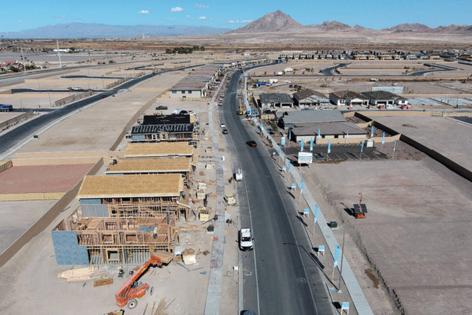Gov. Joe Lombardo eyes federal land for Nevada development in agreement
Published in News & Features
Nevada and the Bureau of Land Management have agreed to share data on public lands that could be released for future development as part of Gov. Joe Lombardo’s larger effort to fix the state’s housing crisis.
The governor’s office and BLM entered a memorandum of understanding Tuesday that lets the state and federal government share data to streamline information and identify future development options on all federally managed land in Nevada.
“This data sharing agreement will enable us to identify land that could be released for attainable housing and development, and this agreement represents a significant step forward in our state and federal partnership,” Lombardo, a Republican, said in a statement to the Review-Journal.
The federal government manages about 80% of all land in Nevada, and Lombardo has long favored addressing Nevada’s housing shortage by opening up some of that land for development, especially around Clark County. A UNLV Lied Center for Real Estate report found a homebuilding slowdown during and after the Great Recession contributed to the state’s limited supply. If construction had stayed at the same pace, more than 281,000 residential structures could have been built between 2010 and 2025, according to the report.
Nicholas Irwin, research director for the Lied Center for Real Estate at UNLV, said Tuesday’s MOU also has practical applications.
“At the state level, there’s no sort of centralized GIS (geographic information system) office,” Irwin said. “Some of the GIS capabilities sit under different agencies. But having all this data coming in for BLM, having it housed in one central location could also be helpful for future decision-making.”
The agreement is set to last for three years and can be extended. There’s no funding requirement tied to either side. Instead, it states that BLM will provide Nevada’s Division of Minerals with data related to federal lands that could be released. The state will provide BLM with the data it identified as available “for disposal” and an interactive map of nearby infrastructure such as roads, schools, parks and commercial areas.
“Sharing reports, documents, tables and data facilities planning for projects, decreases the need for redundant collection of the same reports, documents, tables and spatial data by the two cooperators, and increases the efficiency of multi-agency organization data collection efforts,” according to the MOU.
Developers and advocates will now be watching to see how the data-sharing impacts the release of lands and the timeline of the “very onerous process” of identifying available federal land, auctioning it and preparing it for development, Irwin said.
“Hopefully, it speeds (the process) up,” he said. “But is it a matter of weeks or months or years?”
Assembly Majority Floor Leader Sandra Jauregui, D-Las Vegas, has several housing-related bills moving through the Nevada Legislature this session, including a resolution urging the federal government to release federally managed land in Nevada for housing. Jauregui said such actions would be “one of the tools in the toolbox,” along with policy changes for renters’ protections, rent stabilization for seniors, housing on commercial land and others.
“All of that together will help chip away at the housing problem, but one of those things alone won’t,” she said. “So, do I know that we need more land to build on? Yes, we do, but right now we have eight years’ land left to build on in the state, so getting more land is going to help us long term, but we also need to focus on those solutions that are going to help us right now in the short term.”
_____
©2025 Las Vegas Review-Journal. Visit reviewjournal.com.. Distributed by Tribune Content Agency, LLC.







Comments